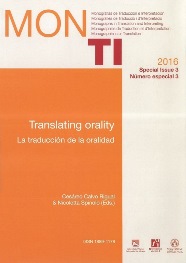Interactions between speaker’s speech rate, orality and emotional involvement, and perceptions of interpreting difficulty: a preliminary study
##plugins.themes.bootstrap3.article.main##
Resum
Descàrregues
##plugins.themes.bootstrap3.article.details##
La propietat intel·lectual dels articles pertany als autors i els drets d'edició i publicació, a la revista. Els articles publicats en la revista podran ser utilitzats lliurement per a propòsits educatius i científics, sempre que se'n faça una correcta citació. Qualsevol ús comercial és expressament penat per la llei.
Referències
Abercrombie, David. (1967) Elements of General Phonetics. Edimburgo: Edinburgh University Press.
Alexieva, Bistra. (1999) “Understanding the Source Language Text in Simultaneous Interpreting.” The Interpreters’ Newsletter 9, pp. 45-59.
Ardito, Giuliana. (1999) “The Systematic Use of Impromptu Speech in Training Interpreting Students.” The Interpreters’ Newsletter 9, pp. 177-189.
Bendazzoli, Claudio & Annalisa Sandrelli. (2005) “An Approach to CorpusBased Interpreting Studies: Developing EPIC (European Parliament Interpreting Corpus).” En: Gerzymisch-Arbogast, Heidrun & Sandra Nauert (eds.) 2005. Proceedings of the Marie Curie Euroconferences MuTra: Challenges of Multidimensional Translation, Saarbrücken 2-6 May. Versión electrónica: http://www.euroconferences.info/proceedings/2005_Proceedings/2005_
Bendazzoli_Sandrelli.pdf
Boersma, Paul & David Weenink. (2001) “PRAAT, A System for Doing Phonetics by Computer.” Glot International 5 (9:10), pp. 341-345.
Ĉeňková, Ivana. (1998) “Quality of Interpreting: A Binding or a Liberating Factor.” En: Beylard-Ozeroff, Ann; Jana Králová & Barbara Moser-Mercer (eds.) 1998. Translators’ Strategies and Creativity. Ámsterdam: John Benjamins, pp. 163-170.
Collados Aís, Ángela. (1998) La evaluación de la calidad en interpretación simultánea. La importancia de la comunicación no verbal. Granada: Comares.
Collados Aís, Ángela; Macarena Pradas Macías; Elisabeth Stévaux & Olalla García Becerra (eds.) (2007) La evaluación de la calidad en interpretación simultánea: parámetros de incidencia. Granada: Comares.
Collados Aís, Ángela; Emilia Iglesias Fernández; Macarena Pradas Macías & Elisabeth Stévaux (eds.) (2011) Qualitätsparameter beim Simultandolmetschen: interdisziplinäre Perspektiven. Tubinga: Gunter Narr.
Cooper, Cary L.; Rachel Davies & Rosalie L. Tung. (1982) “Interpreting Stress: Sources of Job Stress among Conference Interpreters.” Multilingua 1:2, pp. 97-107.
Dam, Helle V. (2001) “On the Option between Form-Based and Meaning-Based Interpreting.” The Interpreters’ Newsletter 11, pp. 28-55.
De Manuel Jerez, Jesús. (2006) La incorporación de la realidad profesional a la formación de intérpretes de conferencias mediante las nuevas tecnologías y la investigación-acción. Granada: Universidad de Granada. Tesis doctoral inédita.
Déjean Le Féal, Karla. (1978) Lectures et improvisations: incidences de la forme de l’ennonciacion sur la traduction simultanée. París: Universitè de Paris III. Tesis doctoral inédita.
Déjean Le Féal, Karla. (1982) “Why Impromptu Speech is Easy to Understand.” En: Enkvist Nils Erik (ed.) 1982. Impromptu Speech. A Symposium. Åbo: Åbo Akademi, pp. 221-239.
ECIS. (2004) “Presentación de proyecto de investigación sobre evaluación de la calidad en interpretación simultánea (BFF2002-00579).” En: Varios autores. 2004. IX Seminario Hispano-Ruso de Traducción e Interpretación. Granada: Atrio, pp. 3-16.
Enkvist, Nils Erik. (1982) “Impromptu Speech, Structure and Process.” En: Enkvist, Nils Erik (ed.) 1982. Impromptu Speech: A Symposium. Åbo: Åbo Akademi, pp. 11-31.
Gerver, David. (1969) “The Effects of Source Language Presentation Rate on the Performance of Simultaneous Conference Interpreters.” En: Pöchhacker, Franz & Miriam Shlesinger (eds.) 2002. The Interpreting Studies Reader. Londres: Routledge, pp. 52-66.
Gile, Daniel. (1995) Basic Concepts and Models for Interpreter and Translator Training. Ámsterdam: John Benjamins.
Gile, Daniel. (2009) Basic Concepts and Models for Interpreter and Translator Training (revised edition). Ámsterdam: John Benjamins.
Iglesias Fernández, Emilia. (2007) “La incidencia del parámetro agradabilidad de la voz.” En: Collados Aís, Ángela; Esperanza M. Pradas Macías; Elizabeth Stévaux & Olalla García Becerra (eds.) 2007. La evaluación de la calidad en interpretación simultánea. Granada: Comares, pp. 37-51.
Iglesias Fernández, Emilia. (2010) “Speaker Fast Tempo and Its Effect on Interpreting Performance.” International Journal of Translation 22:1, pp. 205-228.
Iglesias Fernández, Emilia. (2015) “Making Sense of Interpreting Difficulty through Corpus-Based Observation. Correlations between Speaker’s Speech Rate, Mode of Presentation, Delivery Profile and Experts’ Judgments of Difficulty.” En: Zwischenberger, Cornelia & Martina Behr (eds.) 2015. Interpreting Quality: A Look Around and Ahead. Berlín: Frank & Timme, pp. 35-65.
Kade, Otto & Claus Cartellieri. (1971) “Some Methodological Aspects of Simultaneous Interpreting.” Babel 17:2, pp. 12-16.
Kalina, Sylvia. (1998) Strategische Prozesse beim Dolmetschen. Tubinga: Gunter Narr.
Lamberger-Felber, Heike. (2001) “Text-Oriented Research into Interpreting: Examples from a Case-Study.” Hermes 26, pp. 39-64.
Laver, John. (1994) Principles of Phonetics. Cambridge: Cambridge University Press.
Lederer, Marianne. (1981) La Traduction Simultanée. París: Minard Lettres Modernes.
Lee, Tae-Hyung. (1999) “Speech Proportion and Accuracy in Simultaneous Interpretation from English into Korean.” Meta 44:2, pp. 260-267.
Liu, Minhua & Yu-Hsien Chiu. (2009) “Assessing Source Material Difficulty for Consecutive Interpreting: Quantifiable Measures and Holistic Judgments.” Interpreting 11:2, pp. 244-266.
Pöchhacker, Franz. (1994a) Simultandolmetschen als komplexes Handeln. Tubinga: Gunter Narr.
Pöchhacker, Franz. (1994b) “Quality Assurance in Simultaneous Interpreting.” En: Dollerup, Cay & Annette Lindegaard (eds.) 1994. Teaching Translation and Interpreting 2: Aims, Insights, Vision. Ámsterdam: John Benjamins, pp. 233-242.
Pradas Macias, Esperanza M. (2003) Repercusión del intraparámetro pausas silenciosas en la fluidez: influencia en las expectativas y en la evaluación de la calidad en interpretación simultánea. Granada. Universidad de Granada. Tesis Doctoral.
Seleskovitch, Danica. (1965) “Colloque sur l’enseignement de l’interprétation.” París: Association Internationale des Interprètes de Conférence.
Seleskovitch, Danica. (1982) “Impromptu Speech and Oral Translation.” En: Enkvist, Nils Erik (ed.) 1982. Impromptu Speech: A Symposium. Åbo: Åbo Akademi, pp. 241- 253.
Setton, Robin. (1999) A Cognitive-Pragmatic Analysis of Simultaneous Interpretation. Ámsterdam: John Benjamins.
Setton, Robin. (2005) “Pointing to Contexts: A Relevance-Theoretic Approach to Assessing Quality and Difficulty in Interpreting.” En: Dam, Helle V.; Jan Engberg & Heidrun Gerzymisch-Arbogast (eds.) 2005. Knowledge Systems and Translation. Berlín & Nueva York: Mouton de Gruyter, pp. 275-312.
Shlesinger, Miriam. (1989) Simultaneous Interpretation as a Factor in Effecting Shifts in the Position of Texts on the Oral-Literate Contínuum. Tel Aviv: Tel Aviv University. Tesis de Máster inédita.
Shlesinger, Miriam. (2003) “Effects of Presentation Rate on Working Memory in Simultaneous Interpreting.” The Interpreters’ Newsletter 12, pp. 37-49.
Varios autores (AIIC). (2002) Workload Study. Versión electrónica: http://www.aiic.net.ViewPage.cfm/article467
Vuorikoski, Anna-Riitta. (2004) A Voice of its Citizens or a Modern Tower of Babel? The Quality of Interpreting as a Function of Political Rhetoric in the European Parliament. Tampere: Tampere University Press.


